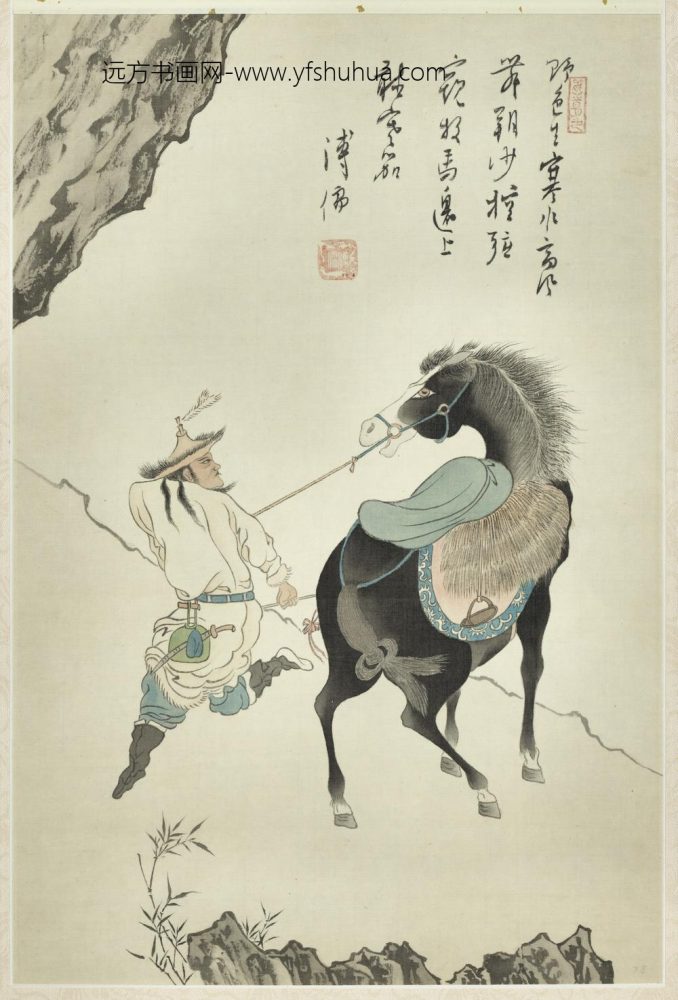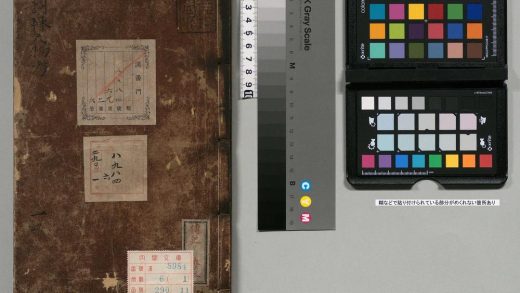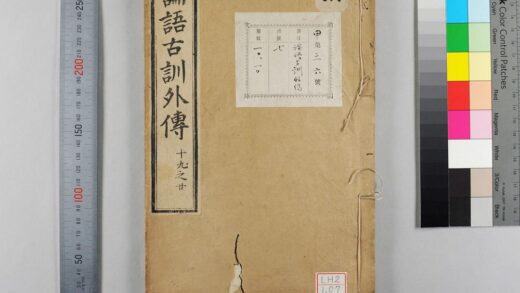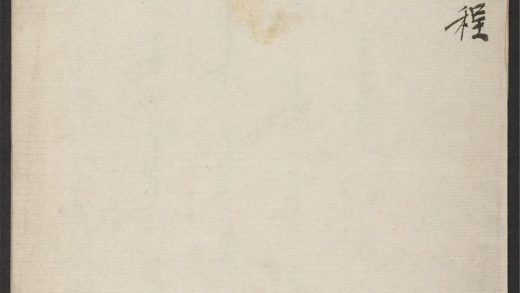【作品基本信息】
| 作者 | 溥儒(溥心畬) |
| 品名 | 鞍马图轴 |
| 朝代 | 近现代 |
| 文件大小 | 18.0MB |
| 分辨率(DPI) | 300×300 |
| 像素大小 | 2017×2975 |
| 尺寸(CM) | 17.07×25.18 |
| 作品数量 | 1 |
| 作品收藏 | 台北故宫博物院 |
| 图片格式 | 默认提供TIF和JPG两个版本 |
基本数据
| 藏品类型 | 绘画 |
| 品名 |
民国溥儒鞍马图 轴 Reining the Horse |
| 分类 | 绘画 |
| 作者 | 溥儒 |
| 数量 | 一轴 |
典藏尺寸
| 【位置】 | 【尺寸】(公分) |
| 本幅 | 45.1×29.8 |
质地
| 【质地位置】 | 【质地】 |
| 本幅 | 纸 |
题跋数据
| 【题跋类别】 | 【作者】 | 【位置】 | 【款识】 | 【书体】 | 【全文】 |
| 作者款识 | 溥心畬 | 本幅 | 野色生寒水。高风舞朔沙。控弦窥牧马。边上听寒笳。 | 行草书 | |
|
印记: 旧时月色、溥儒 |
|||||
印记资料
| 【印记类别】 | 【印记】 |
主题
| 【主题类别】 | 【主题(第一层)】 | 【主题(第二层)】 | 【主题说明】 |
| 主要主题 | 人物 | 圉人 | |
| 主要主题 | 走兽 | 马 | |
| 其他主题 | 器用 | 马鞍 |
技法
| 【技法】 | 【技法细目】 |
| 皴法 | |
| 人物衣纹描法(粗细线条) |
参考数据
| 【类别】 | 【参考数据】 |
| 收藏着录 | 故宫受赠文物选萃,页93、153 |
| 内容简介(中文) |
溥儒(公元一八九六-六三年),河北宛平人。字心畬,清宗室,恭亲王之后。幼年即究心诗词、绘事、书法。工山水,喜用熟纸临摹马夏一派之作。与张大千有南张北溥之称。 本幅为溥氏临仿古人蕃马图的作品,他以属于自己风格的清俊线条,和淡雅的设色,给予古画另一种清新的风味。 |
| 内容简介(英文) |
Saddling the Horse P’u Ju (1886-1963) Republican Period P’u Ju was a scion of the Ch’ing imperial family and was a descendant of the famous Prince Kung. When he was young, he began to study belles-lettres, calligraphy, and painting. He was particularly skilled at landscape painting and was fond of using sized paper, which enables the artist to use different brush techniques. P’u Ju’s style follows the Ma-Hsia school, named for the Southern Sung masters Ma Yuan and Hsia Kuei. Because his fame is comparable to that of his Southern contemporary Chang Ta-ch’ien (1899-1983), they are often referred to as “Southern Chang and Northern P’u.” In this painting, P’u emulates the manner of an earlier horse painting. However, he still follows the path of his own style. By using pastel colors, he gives the ancient composition a fresh flavor. |
| 内容简介(中文) | 溥心畬先生的画路宽广,「鞍马图」的题材即是其中之一。画马的经验,一方面来自临古,一方面则是本身生活的体验。满族皇室子弟,向例要求文武双全,因此骑马射箭为必须学习。「人马图」与「临唐人奚官调马图」出自古人画本,用细致而流畅之线条,虽云工整,而落笔运转顿挫毕见,设色也属于清灵雅逸,一贯溥氏本色。相对于这两幅画的沉静,「蒙古骑士」画策马高岗,背景之山岗岩壁,用笔固然放纵,而人物服饰具边疆民族特色,然细审其人马造形,实出于美国描述西部武打牧人电影,这可以说将中外古今,巧妙地溶合表现。 |
| 内容简介(英文) | P’u Hsin-yu’s painting is both broad and varied, and depictions of riders and horses is one genre within his oeuvre. In painting horses, P’u Hsin-yu both copied ancient models and learned from his own experiences. The male descendents of the Manchu rulers were required to excel in both literary and military prusuits, so they had to learn to ride a horse and shoot arrows while on horseback. P’u Hsin-yu drew inspiration for Horse and Groom and Groom Taming a Horse from ancient paintings. He used fine and fluid brushlines, painting with extreme care. His brushwork and brush movement as well as his clear and elegant colors reveals his personal style. In contrast, Mongolian Rider, is totally different. A Mongolian rider and horse are depicted in profile on a high outcrop in front of a mountain peak. The brushwork is swift and free, and the rider is dressed in clothing worn by people on the borders of China. Looking closely at the horse and rider, one may surmise that P’u Hsin-yu took as his models the cowboys he saw in American Westerns. In this way, P’u Hsin-yu was able to synthesize both Chinese and Western, ancient and modern idioms. |
| 内容简介(英文) |
Paintings of ladies, according to painting texts, should reveal the gentleness, serenity, and purity of women. Lady by a Plantain Tree and Lady Holding a silk Fan are both depictions of women at leisure in which feminine grace and beauty are extolled. P’u Hsin-yu was able to capture the beauty of women while eschewing overly pretty depictions. Also among P’u Hsin-yu oeuvre are subjects from popular folk tales and legends. P’u Hsin-yu derived paintings such as Kuan-yu, General Kuan Yu, and Guardian Deity of Students and Scholars from older compositions and invested them with a new vitality through his brushwork. For instance, the flying sashes in Guardian Dity of Students and Scholars are adapted from the “wind-blown scarves of Wu Tap-tzu,” an idiom in figure painting. P’u Hsin-yu collaborated with Chang Dai-chien in Old Friends Conversing in the Shade of a Pine. Chang Dai-chien painted the figure dressed in a traditional long robe, while P’u Hsin-yu painted the one with a hat. The poem reflects upon the sorrow of having left one’s home country. |
| 参考书目 | 1.林柏亭、张华芝,〈民国溥儒鞍马图〉,收入林柏亭、张华芝编,《画马名品特展图录》(台北:国立故宫博物院,1990年元月初版),页108。 |
| 收藏着录 | 溥心畬先生书画特展目录,页35、82 |
【作品展示】

民国溥儒鞍马图轴民国溥儒鞍马图轴




